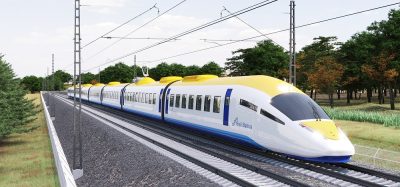Intensified focus on network maintenance
Posted: 31 May 2005 | | No comments yet
SBB Infrastructure has started an extensive programme to improve the availability and reliability of its network in order to guarantee the service level after the substantial expansion of the train schedule.
SBB Infrastructure has started an extensive programme to improve the availability and reliability of its network in order to guarantee the service level after the substantial expansion of the train schedule.
SBB Infrastructure has started an extensive programme to improve the availability and reliability of its network in order to guarantee the service level after the substantial expansion of the train schedule.
On December 12 2004, SBB made a great leap forward. Overnight the new Rail 2000 schedule saw an increase of train kilometres by 14%. The majority of Swiss cities now enjoy train connections twice every hour. Local traffic in and around urban centres such as Berne, Lucerne, Zug and in the Italian part of Switzerland were also improved at the same time. The change was substantial as 90% of the train departures had to be adapted to fit the new schedule.
The basis for the biggest improvement of the passenger train schedule since the introduction of the interval timetable in 1982 was the completion of a new railway line in the heart of the Swiss train network. SBB took into service 45km of double track between Bern and Olten and 10km of single track between Solothurn and its interconnection to the new line near the town of Herzogenbuchsee. The two merging lines from Bern and Solothurn form a ‘Y’ toward the east and improve journey times between Bern/Biel and cities such as Zurich, Basle and Lucerne by 10 to 15 minutes. The new line took eight years to build and cost nearly CHF 1.7 billion.
As a whole, SBB invested CHF 5.9 billion to complete the Rail 2000 concept over the last 15 years. The new rail infrastructure of 160km of new track enabled SBB to improve its offer in rail passenger transport since 1997 in steps by 31% altogether.
140 trains per line and day
With the Rail 2000 offer SBB set a new standard in traffic density. On average any particular SBB line now accommodates close to 140 trains per day. On certain sections of double track lines the number of trains a day surpass 350, a barrier which scheduling experts describe as ‘over saturated’. Particular for SBB’s network is the fact that different train categories share the same tracks: Euro- and Intercities, suburban and local passenger trains, heavy goods and postal trains.
With the completion of the Rail 2000 project, SBB’s intensive expansion and renewal programme comes to a conclusion. The focus of the activities of SBB Infrastructure gradually shifts toward a new main task: guaranteeing a high network performance. Tracks, overhead wirings, points, signals, interlockings, remote control systems, energy supplies and data transfer networks: all have to excel with a performance level which warrants the smooth functioning of SBB’s ambitious train schedule. Running 12% more trains from one day to the next means that the consequences of a technical fault will spread quicker and involve more trains than before, thereby affecting more rail customers, all of them expecting to reach their destinations within the scheduled time.
Running a network used by more than 9,000 trains a day means SBB has a reputation for a high standard of punctuality to defend. The number of passenger trains reaching their destination less than five minutes off schedule improved from 94% in the year 2000 to 95.5% in 2004. In the same year, 92% of the freight trains arrived at their Swiss destinations within 30 minutes of the planned time. These punctuality values also include the performance of third parties, which by now account for more than 10% of the ton-kilometres.
Numerous projects in the pipeline
The focus shift in our main activities from network expansion to network maintenance will improve our performance. The only way the partners using SBB’s tracks – be it our sister divisions from passenger and goods or companies buying track slots as third parties – can be satisfied is when they can depend on three reliable rail-, power- and data-networks provided by SBB Infrastructure. Consequently, it has become the strategic goal of our organisational entity to enable the success of our partners by maintaining a track system with an outstanding performance. The results of a well maintained infrastructure are punctually and safely running trains, the two most precious assets of a well-run network.
SBB Infrastructure has started an extensive programme to improve the reliability of its network infrastructure. Several major SBB internal projects shall lift the network to an even higher level of performance:
- The project ‘Forza’ (‘Advance’) comprises of a cluster of measures to improve the reliability of technical installations. “To keep it simple and to build it robust” is our slogan. We expect to improve the steadfastness of our performance by reducing the number of different types of components we install. The programme also seeks to improve the professional level and the know-how of the staff. In addition, a special information campaign for the maintenance personnel is supposed to increase the internal awareness of the staff while doing repair or replacement works.
- The project ‘10,000 delay minutes per month are enough’ aims to improve the performance of SBB signalling installations. The goal is to reduce the number of traffic delays caused by faulty equipment. It is a very ambitious goal in view of the fact that the level of delay minutes per month currently oscillates between 25,000 and 30,000 minutes.
- The third goal is to improve intervention times. We want to substantially shorten the time it takes from the beginning of a technical disturbance until the repair team reaches the trouble spot and can start the repair work. In the five major centres where disturbances have the biggest consequences for the network as a whole – Zurich, Basle, Berne, Lausanne and Olten – the time for intervention will be cut from 30 to 15 minutes. In a second step the performance level for infrastructure repairs will be improved within the whole network of more than 3,000km of tracks and 750 stations.
- In case of disturbances, our customers expect quick, concise and precise information in and outside the trains. A new schooling and awareness programme and better support tools shall contribute to improve the quality of our customer information.
- The further project is the founding of an in-house education programme named ‘Academy of Rail Infrastructure’. Starting this autumn, the additional intensive internal schooling will help to improve the skill level of our maintenance staff to cope with the quick developments of the technical systems for rail infrastructure.
- Last but not least, SBB Infrastructure set up a new organisational unit to supervise quality and safety within the division. So far this control unit was established solely on a corporate level. The new entity is responsible to design and implement measures to avoid unsafe actions. It will also seek to certify the most important processes within the division.
It is essential that the various projects are well coordinated. Safety and top quality maintenance must be in everybody’s head. It is our permanent management duty to convey this message and to secure its implementation.
Aside from the focus of well performing technical equipment, we have to become more efficient in managing the growing traffic. The interlockings of two thirds of SBB’s railway stations are already remote controlled today; the rest will follow soon. For that reason SBB ordered software packages such as ‘Rail Control System’ (RCS) and ‘ILTIS-Network’ which will support our traffic controllers and operators in their job to cope with the expanding remote control regions while handling the growing traffic density. Step by step the overall dispatchers and the operators in the remote control centres and in railway stations will move into the same locations to work hand in hand. In the Italian part of Switzerland both tasks were successfully united under one roof in order to meet modern requirements of traffic control. Next steps are planned in Lausanne. After the installation of the required software and hardware, our rail network will be controlled and operated from five to six centres in various parts of the country.
One particular measure to increase the capacity of railway lines is a new signalling system. Together with the suppliers SBB is currently working hard to put the European Train Control System (ETCS level 2) into service on its new Rail 2000 line between Bern and Olten. Development delays forced SBB to start commercial service with conventional signalling at a reduced speed in December 2004. Currently, ETCS test runs take place after midnight when the signalling system switches to ETCS. On this particular line SBB expects to start commercial service with ETCS by the end of 2006. In December 2007, when the ‘Lötschberg Base Tunnel’ through the Alps goes into service with ETCS-signalling, more than 560 locomotives will carry ETCS equipment. It is our task to implement the systems on both lines and to make sure that the two future projects advance in a coordinated manner. The test results of the systems are quite positive. However, it turns out that development and engineering costs are substantially higher than anticipated. To a certain extent SBB pays the toll for being an early adaptor of ETCS.
It will be a big challenge for SBB Infrastructure to cope with the growing demand for train slots, particularly on the North-South corridors, but also on the East-West corridor and in most urban regions. The opening of the Lötschberg base tunnel in 2007 will improve alpine rail capacity. At the same time it is our task to provide enough track capacity for additional trains to ‘feed’ the new tunnel system. We are planning well ahead, trying to eliminate the various bottlenecks on our network en route to the Alps. SBB Infrastructure expects an increase in the demand for slot kilometres by more than 10% until 2010. This number includes transit freight and improved intercity and suburban passenger service as well. A long-term study for Zurich expects public transportation to grow by 25% until the year 2025. SBB Infrastructure shall be the basis for the successful growth.






